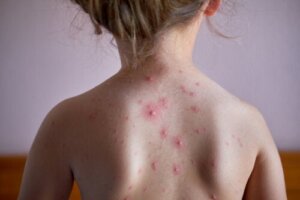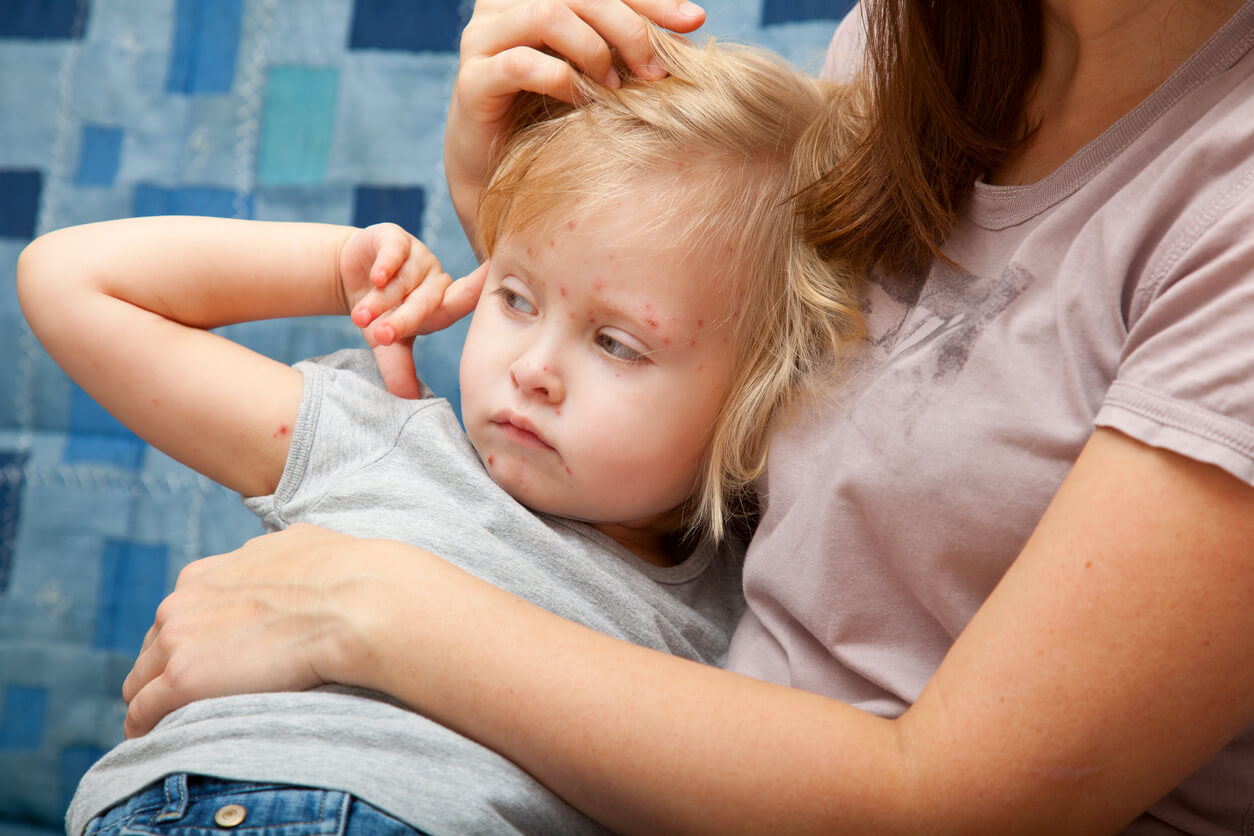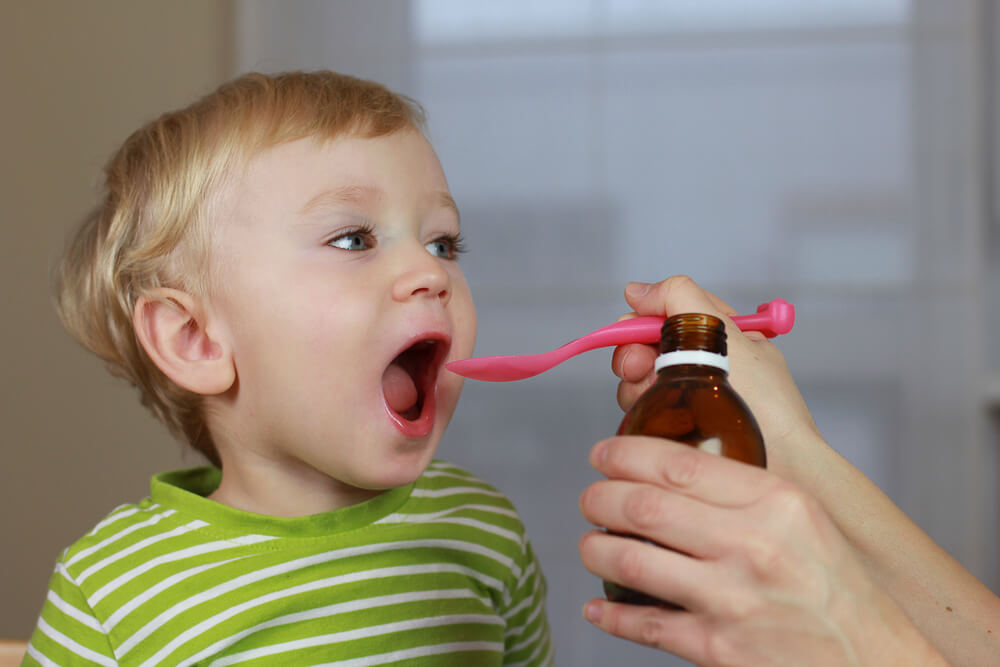Shingles in Children: What Is It and How Does It Affect Them?

Shingles in children isn’t a very common condition. However, when it appears on the skin, it’s usually very annoying and painful, affecting the child’s quality of life.
There are ways to prevent it and therapeutic options to soothe the discomfort. Discover everything you need to know about it in the following article.
What is shingles?
Herpes zoster, also known as shingles, is a disease caused by the reactivation of the varicella zoster virus (VZV). In fact, it can be triggered at any time after vaccination against chickenpox or natural infection with this virus.
It can be said that the incidence of shingles increases with age, although children who’ve had chickenpox within the first year are more likely to develop it.
In general, shingles isn’t a very common dermatological disease in children. However, some little ones are more likely to get it, especially when they meet the following conditions:
- The mother had chickenpox disease in late pregnancy.
- The child had chickenpox before the age of one year.
- There’s a deficiency in the child’s immunity, either due to a medical condition or certain drugs (such as cancer medications).
Read also: What Are Those Little Red Spots on My Baby’s Skin?

Clinical manifestations of shingles in children
When infection is triggered early in life, symptoms tend to be less severe and last, on average, 1 to 3 weeks. In general, reactivation appears initially with intense pain and paresthesia (tingling sensation), followed by the appearance of a cluster of vesicles at that location.
It’s important to note that the rash is limited to a specific dermatome and to only one side of the body. After some time, the vesicles break up, crust over, and after a few weeks, the lesions disappear completely. In most cases, itching, paresthesia, and pain persist as long as the blisters are present.
In addition to the skin lesions, the child may also manifest any of the following symptoms:
- Nausea
- Headache
- Fever
- Chills
It’s not a good idea to implement any home remedies to treat the clinical picture. Rather, it’s best to consult a physician to obtain an accurate diagnosis and the most effective treatment for this condition.
Proper skin hygiene should be encouraged, as the vesicular rash of shingles can become infected with bacteria and cause cellulitis.
Vaccination is the most effective method of prevention
Although cases of shingles in children have decreased significantly since the introduction of the vaccine against VZV, when it affects children, it resolves quickly. Therefore, vaccinated children don’t usually develop chickenpox as they used to, although the virus remains latent in the neural ganglia and can be reactivated in stressful situations.
Chickenpox is a highly contagious disease. According to the Centers for Disease Control and Prevention, two doses of the VZV vaccine are more than 90% effective in preventing the disease. Therefore, the incidence of shingles is significantly lower after mass vaccination.
You may be interested in: Ramsay Hunt Syndrome, the Condition that Justin Bieber Has
Treatment options for shingles
Treatment options are based on the patient’s immune status, age, symptom presentation, and duration. In general, management consists of the use of antiviral agents if the rash is acute, which decreases the duration of the condition and the intensity of pain.
Oral acyclovir at a dose of 20 to 40 mg/kg body weight, four times daily, is indicated as the first line of treatment for shingles in children. At the same time, a study conducted by The Journal of Infectious diseases suggests that the use of acyclovir in healthy children isn’t clearly justified and should be limited to specific cases that require it.

Is shingles in children associated with malignancy?
Shingles in children has long been considered an indicator of oncological disease, especially acute lymphoid leukemia. However, recent studies suggest that neoplasms account for only 3% of cases of shingles in children.
Diagnosing shingles is essential for children
In conclusion, although chickenpox in early childhood is a risk factor, shingles is a rare disease in children. Furthermore, the appearance of symptoms in a young child doesn’t always determine underlying malignancy or immunosuppression.
In general, the prognosis of shingles in healthy children is good and its diagnosis is important to consider the management of shingles.
Shingles in children isn’t a very common condition. However, when it appears on the skin, it’s usually very annoying and painful, affecting the child’s quality of life.
There are ways to prevent it and therapeutic options to soothe the discomfort. Discover everything you need to know about it in the following article.
What is shingles?
Herpes zoster, also known as shingles, is a disease caused by the reactivation of the varicella zoster virus (VZV). In fact, it can be triggered at any time after vaccination against chickenpox or natural infection with this virus.
It can be said that the incidence of shingles increases with age, although children who’ve had chickenpox within the first year are more likely to develop it.
In general, shingles isn’t a very common dermatological disease in children. However, some little ones are more likely to get it, especially when they meet the following conditions:
- The mother had chickenpox disease in late pregnancy.
- The child had chickenpox before the age of one year.
- There’s a deficiency in the child’s immunity, either due to a medical condition or certain drugs (such as cancer medications).
Read also: What Are Those Little Red Spots on My Baby’s Skin?

Clinical manifestations of shingles in children
When infection is triggered early in life, symptoms tend to be less severe and last, on average, 1 to 3 weeks. In general, reactivation appears initially with intense pain and paresthesia (tingling sensation), followed by the appearance of a cluster of vesicles at that location.
It’s important to note that the rash is limited to a specific dermatome and to only one side of the body. After some time, the vesicles break up, crust over, and after a few weeks, the lesions disappear completely. In most cases, itching, paresthesia, and pain persist as long as the blisters are present.
In addition to the skin lesions, the child may also manifest any of the following symptoms:
- Nausea
- Headache
- Fever
- Chills
It’s not a good idea to implement any home remedies to treat the clinical picture. Rather, it’s best to consult a physician to obtain an accurate diagnosis and the most effective treatment for this condition.
Proper skin hygiene should be encouraged, as the vesicular rash of shingles can become infected with bacteria and cause cellulitis.
Vaccination is the most effective method of prevention
Although cases of shingles in children have decreased significantly since the introduction of the vaccine against VZV, when it affects children, it resolves quickly. Therefore, vaccinated children don’t usually develop chickenpox as they used to, although the virus remains latent in the neural ganglia and can be reactivated in stressful situations.
Chickenpox is a highly contagious disease. According to the Centers for Disease Control and Prevention, two doses of the VZV vaccine are more than 90% effective in preventing the disease. Therefore, the incidence of shingles is significantly lower after mass vaccination.
You may be interested in: Ramsay Hunt Syndrome, the Condition that Justin Bieber Has
Treatment options for shingles
Treatment options are based on the patient’s immune status, age, symptom presentation, and duration. In general, management consists of the use of antiviral agents if the rash is acute, which decreases the duration of the condition and the intensity of pain.
Oral acyclovir at a dose of 20 to 40 mg/kg body weight, four times daily, is indicated as the first line of treatment for shingles in children. At the same time, a study conducted by The Journal of Infectious diseases suggests that the use of acyclovir in healthy children isn’t clearly justified and should be limited to specific cases that require it.

Is shingles in children associated with malignancy?
Shingles in children has long been considered an indicator of oncological disease, especially acute lymphoid leukemia. However, recent studies suggest that neoplasms account for only 3% of cases of shingles in children.
Diagnosing shingles is essential for children
In conclusion, although chickenpox in early childhood is a risk factor, shingles is a rare disease in children. Furthermore, the appearance of symptoms in a young child doesn’t always determine underlying malignancy or immunosuppression.
In general, the prognosis of shingles in healthy children is good and its diagnosis is important to consider the management of shingles.
All cited sources were thoroughly reviewed by our team to ensure their quality, reliability, currency, and validity. The bibliography of this article was considered reliable and of academic or scientific accuracy.
- Centers for Diseases Control and Prevention. Vaccination. [Internet] Disponible en: https://www.cdc.gov/chickenpox/vaccination.html
- Pahud BA, Glaser CA, Dekker CL, Arvin AM, Schmid DS. Varicella zoster disease of the central nervous system: epidemiological, clinical, and laboratory features 10 years after the introduction of the varicella vaccine. J Infect Dis. 2011 Feb 1;203(3):316-23. doi: 10.1093/infdis/jiq066. Epub 2010 Dec 21. PMID: 21177308; PMCID: PMC3071104.
- Feder HM Jr, Hoss DM. Herpes zoster in otherwise healthy children. Pediatr Infect Dis J. 2004 May;23(5):451-7; quiz 458-60. doi: 10.1097/01.inf.0000126901.88982.32. PMID: 15131470.
- Kanamori K, Shoji K, Kinoshita N, Ishiguro A, Miyairi I. Complications of herpes zoster in children. Pediatr Int. 2019 Dec;61(12):1216-1220. doi: 10.1111/ped.14025. Epub 2019 Dec 9. PMID: 31628883.
This text is provided for informational purposes only and does not replace consultation with a professional. If in doubt, consult your specialist.








